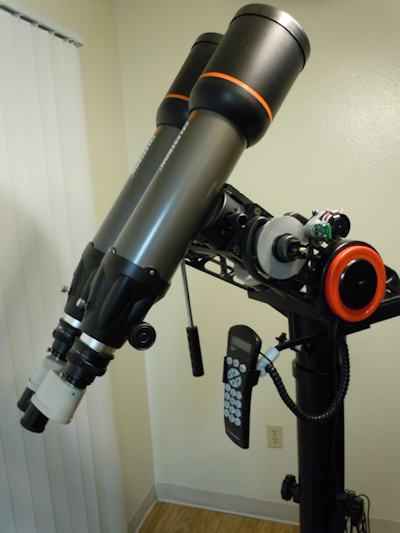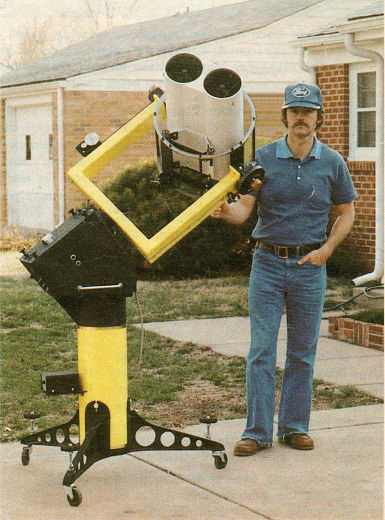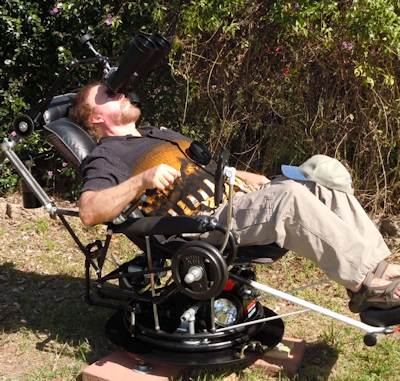Binoscope: Definition, Comparison, How to Build
A binoscope is an optical device that combines two identical telescopes mounted side by side to provide a unique, immersive, and three-dimensional viewing experience. The alignment of the two telescopes allows for binocular viewing, enabling the brain to combine images from both eyes, resulting in a brighter and more detailed image compared to monocular viewing.
The design of a binoscope requires careful engineering to align the two optical tubes and accommodate the interpupillary distance between human eyes, which varies from person to person. Adjustability is crucial for a comfortable viewing experience. Larger aperture binoscopes offer more light-gathering power compared to a single telescope of the same aperture, resulting in even brighter and more detailed images.
A binoscope differs from a telescope in several ways, including design, optical paths, viewing experience, light-gathering power, field of view, usage, and portability. A binoscope essentially combines two telescopes to allow for binocular viewing, providing a stereoscopic 3D view that significantly enhances the observer’s experience. Telescope is a single optical instrument designed for monocular viewing. Binoscopes are used for terrestrial observation, such as birdwatching and surveillance, while telescopes are used for both terrestrial and astronomical observations.
To build a binoscope you should gather two identical refracting or reflecting telescopes with the same focal lengths and apertures, a binoscope bridge or mounting system, prisms or mirrors, and eyepieces with a focal length of around 10 mm to 30 mm. The telescopes should be mounted on the binoscope bridge, ensuring they are parallel and aligned with each other. The interpupillary distance should be adjusted to accommodate different users, and the optical axis of each telescope should coincide with the bridge’s centerline using a beam splitter or dichroic mirror. Each telescope should be focused independently, and the binoscope bridge should be adjusted to merge the images from each telescope.
What is a binoscope?

A binoscope is an optical device that combines two identical telescopes, mounted side by side, to provide a unique and immersive viewing experience. The meaning of the term “binoscope” is derived from the Greek words “binos,” meaning two-eyed, and “skopein,” meaning to observe or examine. This optical instrument emphasizes its ability to provide a three-dimensional visual experience by utilizing both eyes simultaneously.
The alignment of the two telescopes in a binoscope is precise, allowing for binocular viewing through both telescopes simultaneously. Alignment enables the brain to combine images from both eyes, a process known as binocular summation. The viewer perceives a brighter and more detailed image compared to monocular viewing.
Binocular or 3D viewing through a binoscope provides an immersive and more realistic experience. Each eye sees a different perspective of the same object, creating a sense of depth and spatial awareness. Using both eyes for observation reduces eye strain and fatigue compared to monocular viewing.
The design of a binoscope requires careful engineering to align the two optical tubes and accommodate the interpupillary distance between human eyes. Distance varies from person to person, and thus, adjustability is crucial for a comfortable viewing experience. Larger aperture binoscopes offer more light-gathering power compared to a single telescope of the same aperture, resulting in even brighter and more detailed images.
What is the difference between binoscope and telescope?
A binoscope is an optical instrument that essentially combines two telescopes to allow for binocular viewing. Binoscope provides a stereoscopic 3D view, which significantly enhances the observer’s experience. Telescope is a single optical instrument designed for monocular viewing. The meaning of a binoscope lies in its ability to offer a more immersive and natural viewing experience compared to a traditional telescope.
Binoscope features two separate optical paths, one for each eye. This dual-path design is what enables the binoscope to deliver a binocular (stereoscopic) view, which enhances depth perception and offers a more immersive experience. Telescope has a single optical path, which results in a monocular viewing experience.
Binoscope doubles the light-gathering power compared to a single telescope of the same aperture size. Binoscope offers a wider combined true field of view, making it an excellent choice for observing larger objects or areas. Quality single larger aperture telescope will still provide higher resolution and magnification capabilities, even when compared to a binoscope of equivalent total aperture.
Binoscopes are used for terrestrial observation, such as birdwatching, surveillance, or observing large-scale events. Their design accommodates the separation between human eyes, making them more comfortable for extended viewing periods. Telescopes are used for both terrestrial and astronomical observations, including viewing celestial bodies like stars, planets, and galaxies.
Binoscopes offer a wider field of view compared to telescopes. Binoscopes have a range of 3-5° as opposed to the 1-2° provided by most telescopes. This wider field of view enables observers to comfortably view larger planets, such as Jupiter and its moons, without the need for constant adjustments.
Building a binoscope requires more complex alignment and adjustment to co-point the two optical tube assemblies (OTAs). Binoscopes are more portable than telescopes. Telescopes, especially those with larger apertures, are more stationary, requiring a tripod or mount for stable operation.

Are binoscopes or telescopes better for observing planets?
Binoscopes are better for observing planets. Telescopes are more versatile for exploring a wider range of celestial targets. The choice between a binoscope and a telescope depends on personal preferences, observing goals, and the specific planetary features you wish to explore.
If you’re interested in building your own binoscope, it’s essential to research the various components and designs available to ensure you create an instrument that meets your observational needs. Careful planning and construction can result in a high-quality binoscope that provides an unparalleled planetary viewing experience.

How to build a binoscope?
To build a binoscope, follow the steps listed below.
- Gather two identical refracting or reflecting telescopes with the same focal lengths and apertures.
- Obtain a binoscope bridge or mounting system to hold the telescopes parallel and aligned.
- Acquire prisms or mirrors to redirect the light paths to the observer’s eyes.
- Choose eyepieces with a focal length of around 10 mm to 30 mm.
- Mount the two telescopes on the binoscope bridge, ensuring they are parallel and aligned with each other.
- Adjust the interpupillary distance (IPD) to accommodate different users, which ranges from 54 mm to 74 mm.
- Adjust the optical axis of each telescope to coincide with the bridge’s centerline using a beam splitter or dichroic mirror.
- Focus each telescope independently using the focuser or helical focuser.
- Adjust the binoscope bridge to merge the images from each telescope.
- Fine-tune the IPD, telescope alignment, and optical axis to achieve a single, clear image.
- Mount the binoscope on a sturdy tripod or equatorial mount.
- Test the instrument under various lighting conditions and perform star tests to ensure proper alignment and sharp image quality.
- Use a collimation tool to maintain optimal performance and image clarity.
- Prioritize optical alignment and component quality throughout the building process.
- Consider building a small, simple binoscope first to learn the techniques and gain experience before investing in a larger project.
Gather the necessary materials, which include two identical refracting or reflecting telescopes with the same focal lengths and apertures. You will need a binoscope bridge or mounting system to hold the telescopes parallel and aligned, as well as prisms or mirrors to redirect the light paths to the observer’s eyes. Choose eyepieces with a focal length of around 10 mm to 30 mm, and consider any additional components required for light path bending, eye relief, and other necessary adjustments.
Align the telescopes. Mount the two telescopes on the binoscope bridge, ensuring they are parallel and aligned with each other. Adjust the interpupillary distance (IPD) to accommodate different users, which ranges from 54 mm to 74 mm. This step is crucial for achieving a comfortable and immersive viewing experience.
Adjust the optical axis of each telescope to coincide with the bridge’s centerline. This can be achieved by using a beam splitter or dichroic mirror to combine the light paths with minimal light loss and aberrations. Proper alignment of the optical axis ensures that the light paths from both telescopes converge at the same point, providing a single, merged image.
Use the focuser or helical focuser to ensure that the image is sharp and clear for each telescope. This step may require some fine-tuning to achieve optimal focus and image quality.
Adjust the binoscope bridge to merge the images from each telescope. Fine-tune the IPD, telescope alignment, and optical axis to achieve a single, clear image. This step may involve iterative adjustments to ensure the best possible viewing experience.
Mount the binoscope on a sturdy tripod or equatorial mount. Test the instrument under various lighting conditions, and perform star tests to ensure proper alignment and sharp image quality. Using a collimation tool can help maintain optimal performance and image clarity.
Pay close attention to optical alignment and collimation procedures. The quality of the individual telescopes plays a significant role in the overall performance of the binoscope. For those new to the process, consider building a small, simple binoscope first to learn the techniques and gain experience before investing in a larger project.
What are books about building binoscopes?
Books about building binoscopes are listed below.
- “Building and Using Binoscopes” by Norman Butler provides modeling and building details for binoscopes, such as a 10-inch f/5 Newtonian with a pipe mount.
- “Building Binoculars: A Guide to Building, Repairing, and Upgrading Binoculars” by Peter Abrahams covers not only the building process but the repair and upgrade of binoculars.
- “The Binocular Telescope: A Guide to Building and Using Binocular Telescopes” by Peter Erwin focuses on the design considerations, optical components, and construction techniques for binocular telescopes.
- “Amateur Telescope Making: Building a Binocular Telescope” by Albert G. Ingalls offers detailed instructions and diagrams for building a binocular telescope.
- “Binocular Astronomy” by Stephen Tonkin provides guidance on selecting and modifying binoculars for astronomical use.
- “The Binocular Handbook” by Laurie Winter covers the design, construction, and use of binoculars, including information on building and customizing binoscopes.
- Numerous academic journals, conference proceedings, and technical books in the field of Optical Engineering, Optics, Optical Instrumentation, and Telescope Engineering discuss the construction of binoscopes.
- Books like “Telescope Optics: A Comprehensive Guide for Amateur Astronomers”, “Astronomical Optics”, and “Optical System Design” offer detailed guidance on building binoscopes.
- “Building Binoculars: A Guide to Assembling and Using Your Own Binocular Telescope” by Peter R. Manly provides a comprehensive guide for assembling a binocular telescope.
Book “Building and Using Binoscopes” by Norman Butler provides modeling and building details for binoscopes, such as a 10-inch f/5 Newtonian with a pipe mount. It aims to enable amateur astronomers to construct their own binoscopes, enhancing their viewing experience of the night sky.
“Building Binoculars: A Guide to Building, Repairing, and Upgrading Binoculars” by Peter Abrahams waspublished in 2013. This book covers not only the building process but the repair and upgrade of binoculars. It goes into optics, mechanics, and materials, providing a well-rounded understanding of binocular construction.
“The Binocular Telescope: A Guide to Building and Using Binocular Telescopes” by Peter Erwin (2003) is an excellent book about binoscope building. It focuses on the design considerations, optical components, and construction techniques for binocular telescopes.
“Amateur Telescope Making: Building a Binocular Telescope” by Albert G. Ingalls (1953). Despite its age, this book offers detailed instructions and diagrams for building a binocular telescope, making it a useful guide for amateur telescope makers.
“Binocular Astronomy” by Stephen Tonkin (2014) covers the use of binoculars in astronomy. It provides guidance on selecting and modifying binoculars for astronomical use, making it a relevant resource for those interested in binoscopes.
“The Binocular Handbook” by Laurie Winter (2017) covers the design, construction, and use of binoculars. It includes information on building and customizing binoscopes, making it a comprehensive resource for those interested in this field.
There are numerous academic journals, conference proceedings, and technical books in the field of Optical Engineering, Optics, Optical Instrumentation, and Telescope Engineering that discuss the construction of binoscopes. Notable publications include The Journal of Optical Engineering (JOE), Applied Optics, Optics Express, The Astronomical Journal, and Telescope Engineering: Proceedings of the SPIE (Society of Photo-Optical Instrumentation Engineers). These publications provide in-depth information on the design, development, and construction of binoscopes, including the selection of optical components, mechanical design, and testing procedures.
